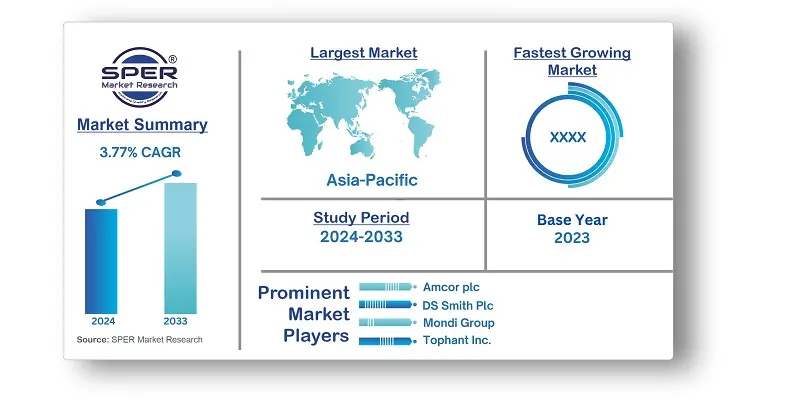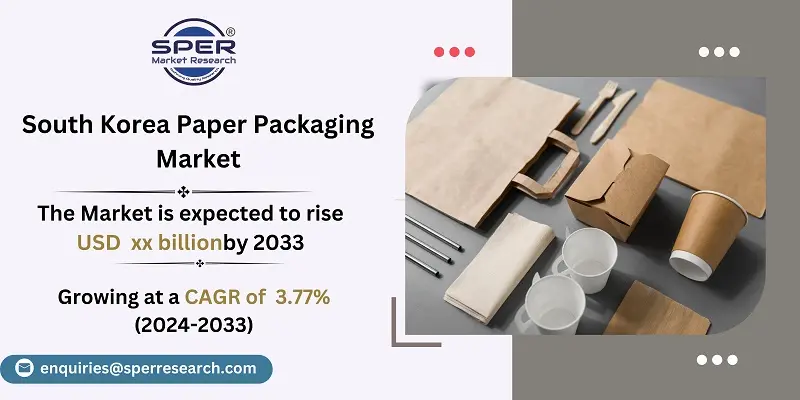
South Korea Paper Packaging Market Growth, Size, Trends, Demand, Revenue and Future Outlook
South Korea Paper Packaging Market Size- By Product, By End User- Regional Outlook, Competitive Strategies and Segment Forecast to 2033
| Published: Apr-2024 | Report ID: PACK2407 | Pages: 1 - 108 | Formats*: |
| Category : Packaging | |||
- October 2022: To be more ecologically friendly, food and beverage company Nestle Confectionery changed the packaging for its Quality Street and KitKat products. Nestle is currently selling paper wrapping for KitKat and Quality Street.
- January 2022: Hansol Paper, a well-known paper producer in Korea, created Hansol EB (Eco Barrier), a flexible packaging substitute for plastic film and aluminum foil.


| Report Metric | Details |
| Market size available for years | 2020-2033 |
| Base year considered | 2023 |
| Forecast period | 2024-2033 |
| Segments covered | By Product, By End User |
| Regions covered | Eastern, Western, Northern, Southern |
| Companies Covered | Amcor plc, DS Smith Plc, Graphic Packaging International Corporation, International Paper Company, Metsa Group, Mondi Group, Oji Paper Co. Ltd, Rengo Co., Ltd., Sappi Limited, Smurfit Kappa Group PLC, Tetra Laval Group, WestPack, Others |
- Consumer Goods Manufacturers
- Food and Beverage Industry
- Pharmaceutical Industry
- Retailers
- E-commerce Companies
- Logistics and Shipping Companies
| By Product Type: |
|
| By End User: |
|
| By Region: |
|
- South Korea Paper Packaging Market Size (FY’2024-FY’2033)
- Overview of South Korea Paper Packaging Market
- Segmentation of South Korea Paper Packaging Market By Product Type (Folding Cartons, Corrugated Boxes, Flexible Paper Packaging, Liquid Cartons, Others)
- Segmentation of South Korea Paper Packaging Market By End User (Food and Beverage, Healthcare, Personal Care and Household Care, Industrial, Others)
- Expansion Analysis of South Korea Paper Packaging Market
- Problems and Obstacles in South Korea Paper Packaging Market
- Competitive Landscape in the South Korea Paper Packaging Market
- Impact of COVID-19 and Demonetization on South Korea Paper Packaging Market
- Details on Current Investment in South Korea Paper Packaging Market
- Competitive Analysis of South Korea Paper Packaging Market
- Prominent Players in the South Korea Paper Packaging Market
- SWOT Analysis of South Korea Paper Packaging Market
- South Korea Paper Packaging Market Future Outlook and Projections (FY’2024-FY’2033)
- Recommendations from Analyst
1.1. Scope of the report1.2. Market segment analysis
2.1. Research data source2.1.1. Secondary Data2.1.2. Primary Data2.1.3. SPER’s internal database2.1.4. Premium insight from KOL’s2.2. Market size estimation2.2.1. Top-down and Bottom-up approach2.3. Data triangulation
4.1. Driver, Restraint, Opportunity and Challenges analysis4.1.1. Drivers4.1.2. Restraints4.1.3. Opportunities4.1.4. Challenges4.2. COVID-19 Impacts of the South Korea Paper Packaging Market
5.1. SWOT Analysis5.1.1. Strengths5.1.2. Weaknesses5.1.3. Opportunities5.1.4. Threats5.2. PESTEL Analysis5.2.1. Political Landscape5.2.2. Economic Landscape5.2.3. Social Landscape5.2.4. Technological Landscape5.2.5. Environmental Landscape5.2.6. Legal Landscape5.3. PORTER’s Five Forces5.3.1. Bargaining power of suppliers5.3.2. Bargaining power of buyers5.3.3. Threat of Substitute5.3.4. Threat of new entrant5.3.5. Competitive rivalry5.4. Heat Map Analysis
6.1. South Korea Paper Packaging Market Manufacturing Base Distribution, Sales Area, Product Type6.2. Mergers & Acquisitions, Partnerships, Product Launch, and Collaboration in South Korea Paper Packaging Market
7.1. South Korea Paper Packaging Market Value Share and Forecast, By Product Type, 2024-20337.2. Folding Cartons7.3. Corrugated Boxes7.4. Flexible Paper Packaging7.5. Liquid Cartons7.6. Others
8.1. South Korea Paper Packaging Market Value Share and Forecast, By End User, 2024-20338.2. Food and Beverage8.3. Healthcare8.4. Personal Care and Household Care8.5. Industrial8.6. Others
9.1. South Korea Paper Packaging Market Size and Market Share
10.1. South Korea Paper Packaging Market Size and Market Share By Product Type (2020-2026)10.2. South Korea Paper Packaging Market Size and Market Share By Product Type (2027-2033)
11.1. South Korea Paper Packaging Market Size and Market Share By End User (2020-2026)11.2. South Korea Paper Packaging Market Size and Market Share By End User (2027-2033)
12.1. South Korea Paper Packaging Market Size and Market Share By Region (2020-2026)12.2. South Korea Paper Packaging Market Size and Market Share By Region (2027-2033)12.3. Southern Region12.4. Northern Region12.5. Western Region12.6. Eastern Region
13.1. Amcor plc13.1.1. Company details13.1.2. Financial outlook13.1.3. Product summary13.1.4. Recent developments13.2. DS Smith Plc13.2.1. Company details13.2.2. Financial outlook13.2.3. Product summary13.2.4. Recent developments13.3. Graphic Packaging International Corporation13.3.1. Company details13.3.2. Financial outlook13.3.3. Product summary13.3.4. Recent developments13.4. International Paper Company13.4.1. Company details13.4.2. Financial outlook13.4.3. Product summary13.4.4. Recent developments13.5. Metsa Group13.5.1. Company details13.5.2. Financial outlook13.5.3. Product summary13.5.4. Recent developments13.6. Mondi Group13.6.1. Company details13.6.2. Financial outlook13.6.3. Product summary13.6.4. Recent developments13.7. Oji Paper Co. Ltd13.7.1. Company details13.7.2. Financial outlook13.7.3. Product summary13.7.4. Recent developments13.8. Rengo Co., Ltd.13.8.1. Company details13.8.2. Financial outlook13.8.3. Product summary13.8.4. Recent developments13.9. Sappi Limited13.9.1. Company details13.9.2. Financial outlook13.9.3. Product summary13.9.4. Recent developments13.10. Smurfit Kappa Group PLC13.10.1. Company details13.10.2. Financial outlook13.10.3. Product summary13.10.4. Recent developments13.11. Tetra Laval Group13.11.1. Company details13.11.2. Financial outlook13.11.3. Product summary13.11.4. Recent developments13.12. WestPack13.12.1. Company details13.12.2. Financial outlook13.12.3. Product summary13.12.4. Recent developments13.13. Others
SPER Market Research’s methodology uses great emphasis on primary research to ensure that the market intelligence insights are up to date, reliable and accurate. Primary interviews are done with players involved in each phase of a supply chain to analyze the market forecasting. The secondary research method is used to help you fully understand how the future markets and the spending patterns look likes.
The report is based on in-depth qualitative and quantitative analysis of the Product Market. The quantitative analysis involves the application of various projection and sampling techniques. The qualitative analysis involves primary interviews, surveys, and vendor briefings. The data gathered as a result of these processes are validated through experts opinion. Our research methodology entails an ideal mixture of primary and secondary initiatives.



Frequently Asked Questions About This Report
PLACE AN ORDER
Year End Discount
Sample Report
Pre-Purchase Inquiry
NEED CUSTOMIZATION?
Request CustomizationCALL OR EMAIL US
100% Secure Payment






Related Reports
Our Global Clients
Our data-driven insights have influenced the strategy of 200+ reputed companies across the globe.




















